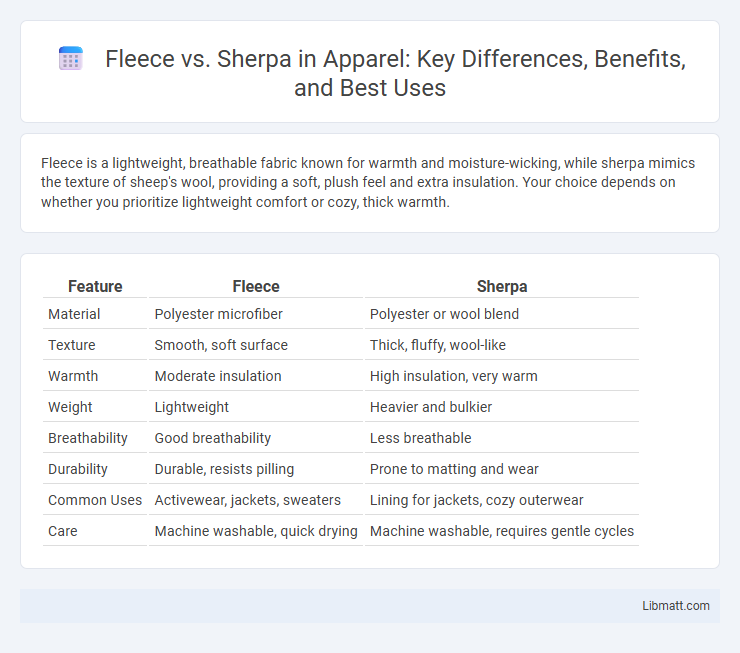Fleece is a lightweight, breathable fabric known for warmth and moisture-wicking, while sherpa mimics the texture of sheep's wool, providing a soft, plush feel and extra insulation. Your choice depends on whether you prioritize lightweight comfort or cozy, thick warmth.
Table of Comparison
| Feature | Fleece | Sherpa |
|---|---|---|
| Material | Polyester microfiber | Polyester or wool blend |
| Texture | Smooth, soft surface | Thick, fluffy, wool-like |
| Warmth | Moderate insulation | High insulation, very warm |
| Weight | Lightweight | Heavier and bulkier |
| Breathability | Good breathability | Less breathable |
| Durability | Durable, resists pilling | Prone to matting and wear |
| Common Uses | Activewear, jackets, sweaters | Lining for jackets, cozy outerwear |
| Care | Machine washable, quick drying | Machine washable, requires gentle cycles |
Introduction to Fleece and Sherpa
Fleece is a synthetic fabric made from polyester, known for its lightweight, warm, and moisture-wicking properties, making it popular in activewear and outdoor clothing. Sherpa is a type of fabric designed to mimic the wool-lined texture of traditional sheepskin, featuring a thick, plush pile that offers superior insulation and softness. Both materials excel in providing warmth, but fleece is typically smoother and more breathable, whereas sherpa emphasizes loft and coziness.
What is Fleece?
Fleece is a synthetic fabric typically made from polyester, designed to provide lightweight warmth and moisture-wicking properties. It features a soft, napped surface that traps heat effectively while remaining breathable and quick-drying. Commonly used in outdoor apparel and blankets, fleece offers excellent insulation without the bulk of heavier materials.
What is Sherpa?
Sherpa is a type of fabric made from soft, thick polyester designed to mimic the texture of real sheep's wool, offering exceptional warmth and comfort. Unlike traditional fleece, Sherpa features a fluffy, wool-like pile that provides superior insulation and a cozy, plush feel ideal for cold weather. Your choice of Sherpa fabric ensures enhanced breathability and durability, making it perfect for jackets, linings, and blankets.
Key Differences Between Fleece and Sherpa
Fleece and sherpa both provide warmth and comfort, but fleece is a lightweight, synthetic fabric made from polyester fibers designed for moisture-wicking and breathability, while sherpa mimics the look and feel of sheepskin with its thick, fluffy texture, offering superior insulation. Fleece's smooth surface makes it ideal for activewear and layering, whereas sherpa's plush, dense pile is often used for cozy linings and outerwear. Your choice depends on whether you prioritize lightweight, moisture-resistant performance or maximum warmth and softness.
Warmth and Insulation: Fleece vs Sherpa
Sherpa fabric offers superior warmth and insulation due to its thick, fluffy texture that traps heat effectively, making it ideal for cold weather. Fleece provides excellent moisture-wicking properties and lightweight insulation, ensuring warmth without bulk. Choosing between fleece and sherpa depends on the desired balance between lightweight comfort and maximum heat retention.
Comfort and Texture Comparison
Fleece offers a smooth, lightweight texture that provides excellent breathability and moisture-wicking properties, making it ideal for active wear and layering. Sherpa features a plush, wool-like texture with a dense, fluffy pile that delivers superior warmth and a cozy, luxurious feel, perfect for cold weather comfort. Choosing between fleece and sherpa depends on your preference for a lightweight, breathable option or a soft, insulating fabric that mimics sheepskin.
Durability and Maintenance
Fleece is known for its durability due to its synthetic polyester fibers, which resist pilling and maintain shape after multiple washes, making it low-maintenance and easy to care for. Sherpa, crafted to mimic sheep's wool, tends to be softer but less durable, requiring gentler washing cycles to prevent matting and wear over time. Proper maintenance of sherpa involves air drying and avoiding high heat, while fleece withstands machine washing and drying without significant damage.
Best Uses for Fleece
Fleece excels in outdoor activities and casual wear due to its lightweight, moisture-wicking, and insulating properties, making it ideal for layering in cold weather. Its quick-drying and breathable nature suits active sports such as hiking, running, and skiing. Fleece also performs well in everyday apparel, offering comfort and warmth without bulk.
Ideal Applications of Sherpa
Sherpa fabric, known for its thick, plush texture and excellent insulation, is ideal for outerwear such as jackets, vests, and cozy linings designed to retain body heat during cold weather. Its moisture-wicking and breathable properties make it perfect for outdoor activities like hiking and camping, where warmth and comfort are essential. If you need superior warmth and softness for cold climates, Sherpa enhances your clothing or gear with its durable, fuzzy finish.
Which Should You Choose: Fleece or Sherpa?
Fleece offers lightweight warmth and moisture-wicking properties, making it ideal for active wear and layering in mild to cool weather. Sherpa, known for its thick, plush texture, provides superior insulation and a cozy feel, perfect for cold, casual settings. Your choice depends on whether you prioritize breathability and mobility (fleece) or maximum warmth and softness (sherpa).
Fleece vs sherpa Infographic

 libmatt.com
libmatt.com